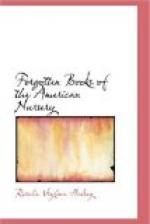[Illustration: A page from a Catalogue of Children’s Books printed by Isaiah Thomas]
Conundrums played their part in the eighteenth century juvenile life, much as they do to-day. These were to be found in “A Bag of Nuts ready Cracked,” and “The Big and Little Puzzling Caps.” “Food for the Mind” was the solemn title of another riddle-book, whose conundrums are very serious matters. Riddle XIV of the “Puzzling Cap” is typical of its rather dreary contents:
“There was a man bespoke a
thing,
Which when the maker home
did bring,
This same maker did refuse
it;
He who bespoke it did not
use it
And he who had it did not
know
Whether he had it, yea or
no.”
This was a nut also “ready cracked” by the answer reproduced in the illustration.
Nature stories were attempted under the titles of “The Natural History of Four Footed Beasts,” “Jacky Dandy’s Delight; or the History of Birds and Beasts in Verse and Prose,” “Mr. Telltruth’s Natural History of Birds,” and “Tommy Trip’s History of Beasts and Birds.” All these were written after Oliver Goldsmith’s “Animated Nature” had won its way into great popularity. As a consequence of the favorable impression this book had made, Goldsmith is supposed to have been asked by Newbery to try his hand upon a juvenile natural history.
Possibly it was as a result of Newbery’s request that we have the anonymous “Jacky Dandy’s Delight” and “Tommy Trip’s History of Beasts and Birds.” The former appears to be a good example of Goldsmith’s facility for amusing himself when doing hack-work for Newbery. How like Goldsmith’s manner is this description of a monkey:
“The monkey mischievous
Like a naughty boy looks;
Who plagues all his
friends,
And regards not his
books.
“He is an active, pert, busy animal, who mimicks human actions so well that some think him rational. The Indians say, he can speak if he pleases, but will not lest he should be set to work. Herein he resembles those naughty little boys who will not learn A, lest they should be obliged to learn B, too. He is a native of warm countries, and a useless beast in this part of the world; so I shall leave him to speak of another that is more bulky, and comes from cold countries: I mean the Bear.”
To poke fun in an offhand manner at little boys and girls seemed to have been the only conception of humor to be found in the children’s books of the period, if we except the “Jests” and the attempts made in a ponderous manner on the title-pages. The title of “The Picture Exhibition; containing the Original Drawings of Eighteen Disciples.... Published under the Inspection of Mr. Peter Paul Rubens,...” is evidently one of Newbery’s efforts to be facetious. To the author, the pretence that the pictures were by “Disciples of Peter Paul Rubens” evidently conveyed the same idea of wit that “Punch” has at times represented to others of a later century.




